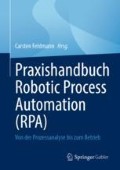Zusammenfassung
Robotic Process Automation (RPA) ermöglicht Unternehmen ihre Prozesse zu automatisieren, ohne dass Eingriffe in die darunterliegenden IT-Systeme notwendig werden. Eine strukturierte Identifikation von Prozessen für diese Roboterautomatisierung, aber auch deren anschließende Überwachung, sind sehr zeitintensive Vorgänge. Process Mining bietet eine effiziente Lösung für diese Herausforderungen an und stellt daher eine logische Ergänzung in jedem RPA-Projekt dar. Process Mining nutzt die Daten, die bei der Anwendung von IT-Systemen zur Durchführung von Prozessen entstehen, um Prozessmodelle zu erstellen und zu analysieren. In diesem Beitrag werden die Grundlagen des Process Mining erläutert und ein umfassender Einblick in die Unterstützungsmöglichkeiten von RPA-Projekten geboten. Process Mining kann alle RPA-Phasen (Assess, Develop und Sustain) sinnvoll ergänzen, indem beispielsweise Nutzeraktionen aufbereitet und analysiert oder Benchmarkings neuer Roboterautomatisierungen durchgeführt werden können. Da Process Mining auf anderen Werkzeugen und Techniken aufbaut, werden zudem Hilfestellungen hinsichtlich der Toolauswahl und Erfolgsfaktoren für Projekte geboten.
Access this chapter
Tax calculation will be finalised at checkout
Purchases are for personal use only
Notes
- 1.
BPM ist neben der IT, Prozessautomation, Operations Research oder Stochastik eine Subdisziplin der Process Science (van der Aalst 2016). Tatsächlich vereint Process Mining die beiden Disziplinen Process- und Data Science. Für das Verständnis und die praktische Anwendung ist die Einordnung in das BPM ausreichend.
- 2.
- 3.
Dies stellt eine vereinfachende Sicht dar. Alternativ könnte RPA als Werkzeug für die Prozess-Redesign und -implementierungs-Phase gesehen oder der BPM-Lebenszyklus mit dem Vorgehen in einem Process-Mining-Projekt verglichen werden. Zum Verständnis dieser Arbeit ist die gewählte Betrachtungsweise ausreichend.
- 4.
- 5.
- 6.
- 7.
- 8.
- 9.
- 10.
- 11.
Literatur
Bitkom Research: Bitkom Digital Office Index 2018: Eine Studie zur Digitalisierung von Büro- und Verwaltungsprozessen in deutschen Unternehmen. https://www.bitkom.org/sites/default/files/file/import/180813-Studienbericht-Bitkom-Digital-Office-Index-2018.pdf (2018). Zugegriffen: 17. Febr. 2022
Cao, L.: Data science: a comprehensive overview. ACM Comput. Surv. 50, 1–42 (2017). https://doi.org/10.1145/3076253
Dreher, S., Reimann, P., Gröger, C.: Application fields and research gaps of process mining in manufacturing companies. Annual Conference of the German Informatics Society, 621–634 (2020)
Dumas, M., La Rosa, M., Mendling, J., Reijers, H.A.: Fundamentals of business process management. Springer Berlin Heidelberg (2018)
Dunzer, S., Zilker, S., Marx, E., Grundler, V., Matzner, M.: The status quo of process mining in the industrial sector. International Conference on Wirtschaftsinformatik, 629–644, (2021)
Drakoulogkonas, P., Apostolou, D.: On the selection of process mining tools. Electronics 451, 451–474 (2021). https://doi.org/10.3390/electronics10040451
Egger, A., ter Hofstede, A., Kratsch, W., Leemans, S., Röglinger, M., Wynn, M.T.: Bot Log Mining: Using Logs from Robotic Process Automation for Process Mining. International Conference on Conceptual Modeling, 51–61 (2020). https://doi.org/10.1007/978-3-030-62522-1_4
Gausemeier, J., Plass, C.: Zukunftsorientierte Unternehmensgestaltung. Strategie, Geschäftsprozesse und IT-Systeme für die Produktion von morgen. Carl Hanser Verlag, München (2014)
Geyer-Klingeberg, J., Nakladal, J., Baldauf, F., Veit, F.: Process Mining and Robotic Process Automation: A Perfect Match. International Conference on Business Process Management (BPM), 124–131 (2018)
Hammond, K., Mathur, A., Moura, B., Mehra, P.: Process mining and its impact on BPM. https://assets.ey.com/content/dam/ey-sites/ey-com/fi_fi/pdf/ey-process-mining-and-its-impact-on-bpm.pdf (2019). Zugegriffen: 05. Febr. 2022
Joppen, R., von Enzberg, S., Kühn, A., Dumitrescu, R.: Data map – method for the specification of data flows within production. Conference on Intelligent Computation in Manufacturing Engineering (ICME), 461–465 (2018). https://doi.org/10.1016/j.procir.2019.02.127
König, M., Bein, L., Nikaj, A., Weske, M.: Integrating robotic process automation into business process management. In: Asatiani et al. (Hrsg.), Business Process Management, S. 132–146. Seville, Spain (2020)
Lechner, P.: BMW: Process Mining @ Production. In: Reinkemeyer, L. (Hrsg.), Process Mining in Action, S. 65–74. Cham. (2020)
Leno, V., Polyvyanyy, A., La Rosa, M., Dumas, M., Maggi, F.M.: Action logger: Enabling process mining for robotic process automation. BPM Demos. 124–128 (2019)
Leno, V., Polyvyanyy, A., Dumas, M., La Rosa, M., Maggi, F.M.: Robotic process mining: Vision and challenges. Bus. Inf. Syst. Eng. 63, 301–314 (2021). https://doi.org/10.1007/s12599-020-00641-4
Mans, R., Reijers, H., Berends, H., Bandara, W., Prince, R.: Business Process Mining Success. 21st European Conference on Information Systems, 102–114 (2013)
Reinkemeyer, L.: How to get started. In: Reinkemeyer, L. (Hrsg.), Process Mining in Action, S. 11–14. Cham. Springer (2020a)
Reinkemeyer, L.: Purpose: Identifying the right use cases. In: Reinkemeyer, L. (Hrsg.), Process Mining in Action, S. 15–26. Cham. Springer (2020b)
Reinkemeyer, L.: People: The human factor. In: Reinkemeyer, L. (Hrsg.), Process Mining in Action, S. 27–30. Cham. Springer (2020c)
Reinkemeyer, L.: Processtraces: Technology. In: Reinkemeyer, L. (Hrsg.), Process Mining in Action, S. 31–36. Cham. Springer (2020d)
Reinkemeyer, L.: Challenges, pitfalls, and failures. In: Reinkemeyer, L. (Hrsg.), Process Mining in Action, S. 37–40. Cham. Springer (2020e)
Schmelzer und Sesselmann: Geschäftsprozessmanagement in der Praxis. Carl Hanser Verlag, München (2010)
Schutt, R., O’Neil, C.: Doing Data Science. O’Reilly, Sebastopol (2014)
Tay, M.: Enhancing business process management with process mining. https://apromore.com/enhancing-business-process-management-with-process-mining/ (2020). Zugegriffen: 05 Febr. 2022
Van der Aalst, W.M.P et al.: Process mining manifesto. Lecture Notes in Business Information Processing, 169–194 (2011)
Van der Aalst, W.M.P: Process mining. Data science in action. Springer, Berlin Heidelberg (2016)
Van der Aalst, W.M.P., Bichler, M., Heinzl, A.: Robotic process automation. Bus. Inf. Syst. Eng. 60, 269–272 (2018). https://doi.org/10.1007/s12599-018-0542-4
Van der Aalst, W.M.P.: On the pareto principle in process mining, task mining, and robotic process automation. DATA 5–12 (2020)
Weske, M.: Business process management. Springer, Berlin Heidelberg (2019)
Author information
Authors and Affiliations
Corresponding author
Editor information
Editors and Affiliations
Rights and permissions
Copyright information
© 2022 Der/die Autor(en), exklusiv lizenziert an Springer Fachmedien Wiesbaden GmbH, ein Teil von Springer Nature
About this chapter
Cite this chapter
Brock, J., von Enzberg, S., Kühn, A., Dumitrescu, R. (2022). Nutzung von Process Mining in RPA-Projekten. In: Feldmann, C. (eds) Praxishandbuch Robotic Process Automation (RPA). Springer Gabler, Wiesbaden. https://doi.org/10.1007/978-3-658-38379-4_5
Download citation
DOI: https://doi.org/10.1007/978-3-658-38379-4_5
Published:
Publisher Name: Springer Gabler, Wiesbaden
Print ISBN: 978-3-658-38378-7
Online ISBN: 978-3-658-38379-4
eBook Packages: Business and Economics (German Language)

